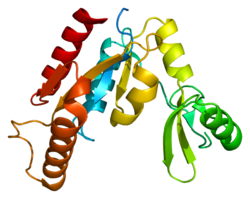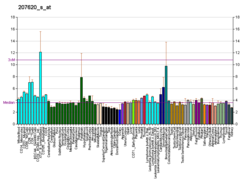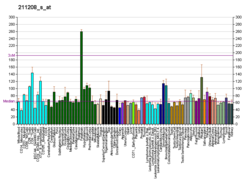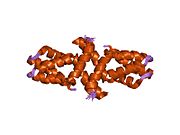Protein-coding gene in humans
| CASK |
|---|
 |
| Available structures |
|---|
| PDB | Ortholog search: PDBe RCSB |
|---|
| List of PDB id codes |
|---|
1KGD, 1KWA, 1ZL8, 3C0G, 3C0H, 3C0I, 3MFR, 3MFS, 3MFT, 3MFU, 3TAC |
|
|
| Identifiers |
|---|
| Aliases | CASK, CAGH39, CAMGUK, CMG, FGS4, LIN2, MICPCH, MRXSNA, TNRC8, calcium/calmodulin-dependent serine protein kinase (MAGUK family), calcium/calmodulin dependent serine protein kinase, hCASK |
|---|
| External IDs | OMIM: 300172 MGI: 1309489 HomoloGene: 2736 GeneCards: CASK |
|---|
|
|
|
|
|
| Wikidata |
|
Peripheral plasma membrane protein CASK is a protein that in humans is encoded by the CASK gene.[5][6] This gene is also known by several other names: CMG 2 (CAMGUK protein 2), calcium/calmodulin-dependent serine protein kinase 3 and membrane-associated guanylate kinase 2. CASK gene mutations are the cause of XL-ID with or without nystagmus and MICPCH, an X-linked neurological disorder.
Gene
This gene is located on the short arm of the X chromosome (Xp11.4). It is 404,253 bases in length and lies on the Crick (minus) strand. The encoded protein has 926 amino acids with a predicted molecular weight of 105,123 daltons.
Function
This protein is a multidomain scaffolding protein with a role in synaptic transmembrane protein anchoring and ion channel trafficking. It interacts with the transcription factor TBR1 and binds to several cell-surface proteins including neurexins and syndecans.
Clinical importance
This gene has been implicated in X-linked mental retardation,[7] including specifically mental retardation and microcephaly with pontine and cerebellar hypoplasia.[8] The role of CASK in disease is primarily associated with a loss of function (under expression) of the CASK gene as a result of a deletion, missense or splice mutation.[9] It appears that mutations in the gene lead to diminished amounts of the protein being coded. As a result, CASK is unable to form complexes with other proteins leading to a cascade of events. Research has shown there is significant down-regulation of the genes involved in pre-synaptic development and of CASK protein interactors.[10]
Males affected by CASK variants tend to have more severe symptoms than females due to the X-linked nature of the disease. These genetic issues are often fatal in the womb for male embryos[11][12] or else lead to infant mortality. Females with CASK mutations have variable phenotypes with moderate to severe intellectual disability. CASK missense mutations and some splice mutations can lead to the milder neurodevelopmental phenotype.[12]
CASK related disorders are mainly found in girls. The prevalence is unknown but generally thought to be below 400 cases worldwide. Patients are often born healthy but within the first few months of life show progressive microcephaly. Although there can be prenatal deceleration of head circumference growth, the majority of cases will not be diagnosed according to current recommendations for fetal CNS routine assessment.[13]
The exact mode of pathology is not clear, but evidence from mice models indicates CASK deficiency in neurones causes the following effects:[14]
- reduced levels of associated proteins such as Mint1[15] and neurexin
- Higher levels of Neuroligin 1
- Increased glutamate release at synapses and reduced GABA release affecting the E/I balance in maturing neural circuits[16]
- Down-regulation of GluN2B resulting in disruption of synaptic E/I balance[17]
Even slight changes in CASK expression in humans leads to dysregulation of the formation of presynapses, especially in inhibitory neurones.[10]
Interactions
CASK has been shown to interact with:
External links











